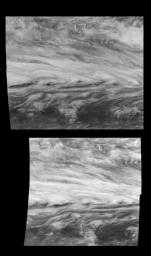
|
Winds Near Jupiter’s Belt-Zone Boundary
- Click the image above for a larger view
- Full-Res JPEG (1000 x 1700) (132.9 kB)
- Full-Res TIFF (1000 x 1700) (884.9 kB)
Caption:
Time Sequence of a belt-zone boundary near Jupiter's equator. These mosaics show Jupiter's appearance at 757 nanometers (near-infrared) and were taken nine hours apart. Images at 757 nanometers show features of Jupiter's primary visible cloud deck.
Jupiter's atmospheric circulation is dominated by alternating jets of east/west (zonal) winds. The bands have different widths and wind speeds but have remained constant as long as telescopes and spacecraft have measured them. A strong eastward jet is made visible as it stretches the clouds just below the center of this mosaic. The maximum wind speed of this jet is 128 meters per second (286 miles per hour). Features on this jet move about one quarter of the width of the mosaic. All the features visible in these mosaics are moving eastward (right).
North is at the top. The mosaic covers latitudes -13 to +3 degrees and is centered at longitude 282 degrees West. The smallest resolved features are tens of kilometers in size. These images were taken on November 5th, 1996, at a range of 1.2 million kilometers by the Solid State Imaging system aboard NASA's Galileo spacecraft.
Background Info:
The Jet Propulsion Laboratory, Pasadena, CA manages the mission for NASA's Office of Space Science, Washington, DC.
This image and other images and data received from Galileo are posted on the World Wide Web, on the Galileo mission home page at URL http://galileo.jpl.nasa.gov. Background information and educational context for the images can be found at http://www.jpl.nasa.gov/galileo/sepo .
Cataloging Keywords:
| Name | Value | Additional Values |
|---|---|---|
| Target | Jupiter | |
| System | Jupiter | |
| Target Type | Planet | |
| Mission | Galileo | |
| Instrument Host | Galileo Orbiter | |
| Host Type | Orbiter | |
| Instrument | Solid-State Imaging (SSI) | |
| Detector | ||
| Extra Keywords | Atmosphere, Grayscale, Infrared | |
| Acquisition Date | ||
| Release Date | 1997-12-18 | |
| Date in Caption | ||
| Image Credit | NASA/JPL-Caltech | |
| Source | photojournal.jpl.nasa.gov/catalog/PIA01113 | |
| Identifier | PIA01113 | |
